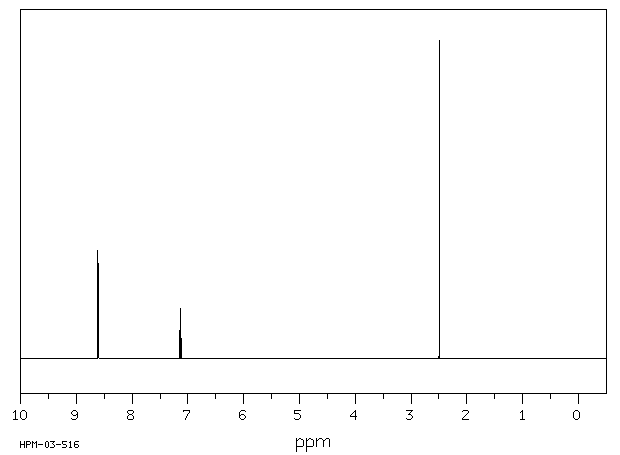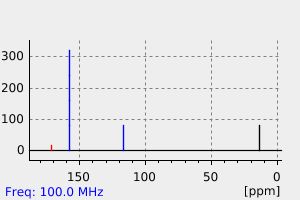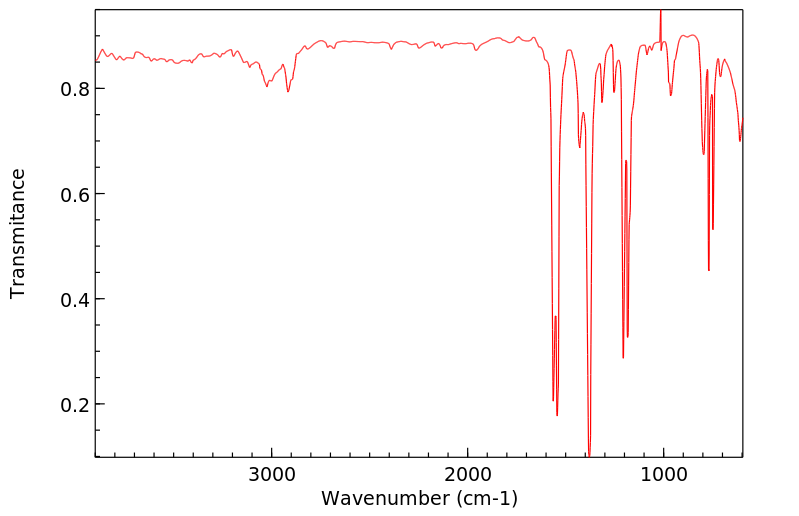2-甲硫基嘧啶 | 823-09-6
中文名称
2-甲硫基嘧啶
中文别名
2-(甲基硫代)嘧啶
英文名称
2-(methylsulfanyl)pyrimidine
英文别名
2-methylthio-pyrimidine;2-Methylmercapto-pyrimidin;2-Methylthio-pyrimidin;2-(Methylthio)pyrimidine;2-methylsulfanylpyrimidine
CAS
823-09-6
化学式
C5H6N2S
mdl
MFCD09025802
分子量
126.182
InChiKey
FOEMIZSFFWGXHX-UHFFFAOYSA-N
BEILSTEIN
——
EINECS
——
-
物化性质
-
计算性质
-
ADMET
-
安全信息
-
SDS
-
制备方法与用途
-
上下游信息
-
文献信息
-
表征谱图
-
同类化合物
-
相关功能分类
-
相关结构分类
物化性质
-
沸点:216℃
-
密度:1.19
-
闪点:84℃
计算性质
-
辛醇/水分配系数(LogP):1
-
重原子数:8
-
可旋转键数:1
-
环数:1.0
-
sp3杂化的碳原子比例:0.2
-
拓扑面积:51.1
-
氢给体数:0
-
氢受体数:3
安全信息
-
安全说明:S26,S36/37/39
-
危险类别码:R36,R36/37/38
-
海关编码:2933599090
-
储存条件:| 室温 |
SDS
SECTION 1: Identification of the substance/mixture and of the company/undertaking
Product identifiers
Product name : 2-Methylthiopyrimidine
REACH No. : A registration number is not available for this substance as the substance
or its uses are exempted from registration, the annual tonnage does not
require a registration or the registration is envisaged for a later
registration deadline.
Relevant identified uses of the substance or mixture and uses advised against
Identified uses : Laboratory chemicals, Manufacture of substances
SECTION 2: Hazards identification
Classification of the substance or mixture
Classification according to Regulation (EC) No 1272/2008
Acute toxicity, Oral (Category 4), H302
Eye irritation (Category 2), H319
For the full text of the H-Statements mentioned in this Section, see Section 16.
Classification according to EU Directives 67/548/EEC or 1999/45/EC
Xn Harmful R22
R36
For the full text of the R-phrases mentioned in this Section, see Section 16.
Label elements
Labelling according Regulation (EC) No 1272/2008
Pictogram
Signal word Warning
Hazard statement(s)
H302 Harmful if swallowed.
H319 Causes serious eye irritation.
Precautionary statement(s)
P305 + P351 + P338 IF IN EYES: Rinse cautiously with water for several minutes. Remove
contact lenses, if present and easy to do. Continue rinsing.
Supplemental Hazard none
Statements
Other hazards
This substance/mixture contains no components considered to be either persistent, bioaccumulative and
toxic (PBT), or very persistent and very bioaccumulative (vPvB) at levels of 0.1% or higher.
SECTION 3: Composition/information on ingredients
Substances
Molecular weight : 126,18 g/mol
Hazardous ingredients according to Regulation (EC) No 1272/2008
Component Classification Concentration
2-Methylthiopyrimidine
Acute Tox. 4; Eye Irrit. 2; <= 100 %
H302, H319
Hazardous ingredients according to Directive 1999/45/EC
Component Classification Concentration
2-Methylthiopyrimidine
Xn, R22R36 <= 100 %
For the full text of the H-Statements and R-Phrases mentioned in this Section, see Section 16
SECTION 4: First aid measures
Description of first aid measures
General advice
Consult a physician. Show this safety data sheet to the doctor in attendance.
If inhaled
If breathed in, move person into fresh air. If not breathing, give artificial respiration. Consult a physician.
In case of skin contact
Wash off with soap and plenty of water. Consult a physician.
In case of eye contact
Rinse thoroughly with plenty of water for at least 15 minutes and consult a physician.
If swallowed
Never give anything by mouth to an unconscious person. Rinse mouth with water. Consult a physician.
Most important symptoms and effects, both acute and delayed
The most important known symptoms and effects are described in the labelling (see section 2.2) and/or in
section 11
Indication of any immediate medical attention and special treatment needed
No data available
SECTION 5: Firefighting measures
Extinguishing media
Suitable extinguishing media
Use water spray, alcohol-resistant foam, dry chemical or carbon dioxide.
Special hazards arising from the substance or mixture
Nature of decomposition products not known.
Advice for firefighters
Wear self-contained breathing apparatus for firefighting if necessary.
Further information
No data available
SECTION 6: Accidental release measures
Personal precautions, protective equipment and emergency procedures
Use personal protective equipment. Avoid dust formation. Avoid breathing vapours, mist or gas. Ensure
adequate ventilation. Avoid breathing dust.
For personal protection see section 8.
Environmental precautions
Do not let product enter drains.
Methods and materials for containment and cleaning up
Pick up and arrange disposal without creating dust. Sweep up and shovel. Keep in suitable, closed
containers for disposal.
Reference to other sections
For disposal see section 13.
SECTION 7: Handling and storage
Precautions for safe handling
Avoid contact with skin and eyes. Avoid formation of dust and aerosols.
Provide appropriate exhaust ventilation at places where dust is formed.
For precautions see section 2.2.
Conditions for safe storage, including any incompatibilities
Store in cool place. Keep container tightly closed in a dry and well-ventilated place.
Storage class (TRGS 510): Non Combustible Solids
Specific end use(s)
Apart from the uses mentioned in section 1.2 no other specific uses are stipulated
SECTION 8: Exposure controls/personal protection
Control parameters
Components with workplace control parameters
Exposure controls
Appropriate engineering controls
Handle in accordance with good industrial hygiene and safety practice. Wash hands before breaks and
at the end of workday.
Personal protective equipment
Eye/face protection
Safety glasses with side-shields conforming to EN166 Use equipment for eye protection tested
and approved under appropriate government standards such as NIOSH (US) or EN 166(EU).
Skin protection
Handle with gloves. Gloves must be inspected prior to use. Use proper glove removal technique
(without touching glove's outer surface) to avoid skin contact with this product. Dispose of
contaminated gloves after use in accordance with applicable laws and good laboratory practices.
Wash and dry hands.
The selected protective gloves have to satisfy the specifications of EU Directive 89/686/EEC and
the standard EN 374 derived from it.
Body Protection
Complete suit protecting against chemicals, The type of protective equipment must be selected
according to the concentration and amount of the dangerous substance at the specific workplace.
Respiratory protection
For nuisance exposures use type P95 (US) or type P1 (EU EN 143) particle respirator.For higher
level protection use type OV/AG/P99 (US) or type ABEK-P2 (EU EN 143) respirator cartridges.
Use respirators and components tested and approved under appropriate government standards
such as NIOSH (US) or CEN (EU).
Control of environmental exposure
Do not let product enter drains.
SECTION 9: Physical and chemical properties
Information on basic physical and chemical properties
a) Appearance Form: solid
b) Odour No data available
c) Odour Threshold No data available
d) pH No data available
e) Melting point/freezing No data available
point
f) Initial boiling point and No data available
boiling range
g) Flash point No data available
h) Evaporation rate No data available
i) Flammability (solid, gas) No data available
j) Upper/lower No data available
flammability or
explosive limits
k) Vapour pressure No data available
l) Vapour density No data available
m) Relative density No data available
n) Water solubility No data available
o) Partition coefficient: n- No data available
octanol/water
p) Auto-ignition No data available
temperature
q) Decomposition No data available
temperature
r) Viscosity No data available
s) Explosive properties No data available
t) Oxidizing properties No data available
Other safety information
No data available
SECTION 10: Stability and reactivity
Reactivity
No data available
Chemical stability
Stable under recommended storage conditions.
Possibility of hazardous reactions
No data available
Conditions to avoid
No data available
Incompatible materials
Strong oxidizing agents
Hazardous decomposition products
In the event of fire: see section 5
SECTION 11: Toxicological information
Information on toxicological effects
Acute toxicity
No data available
Skin corrosion/irritation
No data available
Serious eye damage/eye irritation
No data available
Respiratory or skin sensitisation
No data available
Germ cell mutagenicity
No data available
Carcinogenicity
IARC: No component of this product present at levels greater than or equal to 0.1% is identified as
probable, possible or confirmed human carcinogen by IARC.
Reproductive toxicity
No data available
Specific target organ toxicity - single exposure
No data available
Specific target organ toxicity - repeated exposure
No data available
Aspiration hazard
No data available
Additional Information
RTECS: Not available
To the best of our knowledge, the chemical, physical, and toxicological properties have not been
thoroughly investigated.
SECTION 12: Ecological information
Toxicity
No data available
Persistence and degradability
No data available
Bioaccumulative potential
No data available
Mobility in soil
No data available
Results of PBT and vPvB assessment
This substance/mixture contains no components considered to be either persistent, bioaccumulative and
toxic (PBT), or very persistent and very bioaccumulative (vPvB) at levels of 0.1% or higher.
Other adverse effects
No data available
SECTION 13: Disposal considerations
Waste treatment methods
Product
Offer surplus and non-recyclable solutions to a licensed disposal company. Dissolve or mix the material
with a combustible solvent and burn in a chemical incinerator equipped with an afterburner and scrubber.
Contaminated packaging
Dispose of as unused product.
SECTION 14: Transport information
UN number
ADR/RID: - IMDG: - IATA: -
UN proper shipping name
ADR/RID: Not dangerous goods
IMDG: Not dangerous goods
IATA: Not dangerous goods
Transport hazard class(es)
ADR/RID: - IMDG: - IATA: -
Packaging group
ADR/RID: - IMDG: - IATA: -
Environmental hazards
ADR/RID: no IMDG Marine pollutant: no IATA: no
Special precautions for user
No data available
SECTION 15: Regulatory information
This safety datasheet complies with the requirements of Regulation (EC) No. 1907/2006.
Safety, health and environmental regulations/legislation specific for the substance or mixture
No data available
Chemical Safety Assessment
For this product a chemical safety assessment was not carried out
SECTION 16: Other information
Full text of H-Statements referred to under sections 2 and 3.
Acute Tox. Acute toxicity
Eye Irrit. Eye irritation
H302 Harmful if swallowed.
H319 Causes serious eye irritation.
Full text of R-phrases referred to under sections 2 and 3
Xn Harmful
R22 Harmful if swallowed.
R36 Irritating to eyes.
Further information
Copyright 2014 Co. LLC. License granted to make unlimited paper copies for internal use
only.
The above information is believed to be correct but does not purport to be all inclusive and shall be
used only as a guide. The information in this document is based on the present state of our knowledge
and is applicable to the product with regard to appropriate safety precautions. It does not represent any
guarantee of the properties of the product. Corporation and its Affiliates shall not be held
liable for any damage resulting from handling or from contact with the above product. See
and/or the reverse side of invoice or packing slip for additional terms and conditions of sale.
上下游信息
-
上游原料
中文名称 英文名称 CAS号 化学式 分子量 5-溴-2-甲巯基嘧啶 5-bromo-2-methylthiopyrimidine 14001-67-3 C5H5BrN2S 205.078 4-碘-2-甲基磺酰基嘧啶 4-iodo-2-(methylthio)pyrimidine 1122-74-3 C5H5IN2S 252.079 2-甲硫基-4-氯嘧啶 4-Chloro-2-methylthiopyrimidine 49844-90-8 C5H5ClN2S 160.627 -
下游产品
中文名称 英文名称 CAS号 化学式 分子量 —— 2-(α,α-difluoromethylthio)pyrimidine —— C5H4F2N2S 162.163 5-溴-2-甲巯基嘧啶 5-bromo-2-methylthiopyrimidine 14001-67-3 C5H5BrN2S 205.078 2-(甲基亚磺酰)嘧啶 2-(methylsulfinyl)pyrimidine 14080-19-4 C5H6N2OS 142.181 2-甲砜基嘧啶 2-(methylsulfonyl)pyrimidine 14161-09-2 C5H6N2O2S 158.181 4-甲基-2-甲硫基嘧啶 2-methylthio-4-methylpyrimidine 14001-63-9 C6H8N2S 140.209 4-碘-2-甲基磺酰基嘧啶 4-iodo-2-(methylthio)pyrimidine 1122-74-3 C5H5IN2S 252.079
反应信息
-
作为反应物:参考文献:名称:Azine and Diazine Functionalization Using 2,2,6,6-Tetramethylpiperidino-Based Lithium–Metal Combinations: Application to the Synthesis of 5,9-Disubstituted Pyrido[3′,2′:4,5]pyrrolo[1,2-c]pyrimidines摘要:The synthesis of triaryl methanols was investigated by reacting different 4-metalated 2-substituted pyrimidines with diaryl ketones, the latter being generated by deprotocupration-aroylation of azine and diazine substrates. Cyclization of the triaryl methanols thus obtained afforded pyrido[3,2:4,5]pyrrolo[1,2-c]pyrimidines, which were evaluated for kinase inhibition and antiproliferative activities in melanoma cells.DOI:10.1055/s-0035-1560496
-
作为产物:描述:参考文献:名称:Matsukawa; Ohta, Yakugaku Zasshi/Journal of the Pharmaceutical Society of Japan, 1950, vol. 70, p. 137摘要:DOI:
文献信息
-
Nickel‐Catalyzed Inter‐ and Intramolecular Aryl Thioether Metathesis by Reversible Arylation作者:Tristan Delcaillau、Alessandro Bismuto、Zhong Lian、Bill MorandiDOI:10.1002/anie.201910436日期:2020.1.27A nickel-catalyzed aryl thioether metathesis has been developed to access high-value thioethers. 1,2-Bis(dicyclohexylphosphino)ethane (dcype) is essential to promote this highly functional-group-tolerant reaction. Furthermore, synthetically challenging macrocycles could be obtained in good yield in an unusual example of ring-closing metathesis that does not involve alkene bonds. In-depth organometallic
-
Photoredox and Weak Brønsted Base Dual Catalysis: Alkylation of α-Thio Alkyl Radicals作者:Edwin Alfonzo、Sudhir M. HandeDOI:10.1021/acscatal.0c03851日期:2020.11.6activation of thioethers to α-thio alkyl radicals and their addition to electron-deficient olefins to afford alkylated products through dual photoredox and weak Brønsted base catalysis. Mechanistic studies are consistent with a two-step activation mechanism, where oxidation of thioethers to their corresponding sulfide radical cations by an acridinium photoredox catalyst is followed with deprotonation by
-
Decyanative Cross-Coupling of Cyanopyrimidines with O-, S-, and N-Nucleophiles: A Route to Alkoxylpyrimidines, Aminopyrimidines and Alkylthiopyrimidines作者:Xiangyang Wei、Caiyang Zhang、Yifei Wang、Qi Zhan、Guiying Qiu、Ling Fan、Guodong YinDOI:10.1002/ejoc.201901364日期:2019.11.14A cross‐coupling reaction of cyanopyrimidines with aliphatic alcohols, thiols (or S‐alkylisothiourea salts) or amines gives the corresponding alkoxylpyrimidines, aminopyrimidines or alkylthiopyrimidines. The wide substrate scope with excellent yields makes cyanopyrimidines a promising alternative substrate class to the frequently used pyrimidines halides for the formation of C–O, C–S, and C–N bonds
-
Pd- and Ni-Catalyzed Cross-Coupling Reactions of Functionalized Organozinc Reagents with Unsaturated Thioethers作者:Laurin Melzig、Albrecht Metzger、Paul KnochelDOI:10.1002/chem.201002850日期:2011.3.1serve as electrophiles in this cross‐coupling reaction. Aryl‐, heteroaryl‐, benzylic, and alkylzinc halides with sensitive functionalities, such as ester, nitrile, or ketone groups react at ambient temperature with unsaturated thioethers using a Ni catalyst. The corresponding Pd‐catalyzed reactions require slightly higher temperatures. Large‐scale cross‐coupling experiments (10–20 mmol) with N‐heterocycles
-
Cesium carbonate-promoted synthesis of aryl methyl sulfides using <i>S</i>-methylisothiourea sulfate under transition-metal-free conditions作者:Caiyang Zhang、You Zhou、Jintao Huang、Canhui Tu、Xiaoai Zhou、Guodong YinDOI:10.1039/c8ob01758a日期:——cyclopropylmethylthio groups can be easily introduced into the aromatic rings from the corresponding S-[2-(dimethylamino)ethyl]isothiourea dihydrochloride and S-cyclopropylmethylisothiourea hydrobromide. The possible reaction mechanism is proposed. It is believed that this route to aryl alkyl sulfides is well competitive with currently known methods due to its wide substrate scope, excellent yields, easy
表征谱图
-
氢谱1HNMR
-
质谱MS
-
碳谱13CNMR
-
红外IR
-
拉曼Raman
-
峰位数据
-
峰位匹配
-
表征信息
同类化合物
(Rp)-2-(叔丁硫基)-1-(二苯基膦基)二茂铁
(1E)-1-{4-[(4-氨基苯基)硫烷基]苯基}乙酮肟
颜料红88
颜料紫36
顺式-1,2-二(乙硫基)-1-丙烯
非班太尔-D6
雷西那得中间体
阿西替尼杂质J
阿西替尼杂质C
阿西替尼杂质4
阿西替尼杂质
阿西替尼
阿拉氟韦
阿扎毒素
阿嗪米特
阔草特
银(I)(6-氨基-2-(甲硫基)-5-亚硝基嘧啶-4-基)酰胺水合物
钾三氟[3-(苯基硫基)丙基]硼酸酯(1-)
邻甲苯基(对甲苯基)硫化物
避虫醇
连翘脂苷B
还原红 41
还原紫3
还原桃红R
达索尼兴
辛硫醚
辛-1,7-二炔-1-基(苯基)硫烷
西嗪草酮
萘,2-[(2,3-二甲基苯基)硫代]-
莫他哌那非
茴香硫醚
苯醌B
苯酰胺,N-(氨基亚氨基甲基)-4-[(2-甲基苯基)硫代]-3-(甲磺酰)-,盐酸盐
苯酰胺,N-(氨基亚氨基甲基)-4-[(2-氯苯基)硫代]-3-(甲磺酰)-,盐酸盐
苯酰胺,N-(氨基亚氨基甲基)-4-[(2,6-二氯苯基)硫代]-3-(甲磺酰)-,盐酸盐
苯酰胺,2-[(2-硝基苯基)硫代]-
苯酚,3-氯-4-[(4-硝基苯基)硫代]-
苯酚,3-(乙硫基)-
苯酚,3,5-二[(苯基硫代)甲基]-
苯胺,4-[5-溴-3-[4-(甲硫基)苯基]-2-噻嗯基]-
苯胺,3-氯-4-[(1-甲基-1H-咪唑-2-基)硫代]-
苯胺,2-[(2-吡啶基甲基)硫代]-
苯硫醚-D10
苯硫胍
苯硫基乙酸
苯硫代磺酸S-(三氯乙烯基)酯
苯甲醇,2,3,4,5,6-五氟-a-[(苯基硫代)甲基]-,(R)-
苯甲酸,3-[[2-[(二甲氨基)甲基]苯基]硫代]-,盐酸
苯甲胺,5-氟-2-((3-甲氧苯基)硫代)-N,N-二甲基-,盐酸
苯甲二硫酸,4-溴苯基酯









